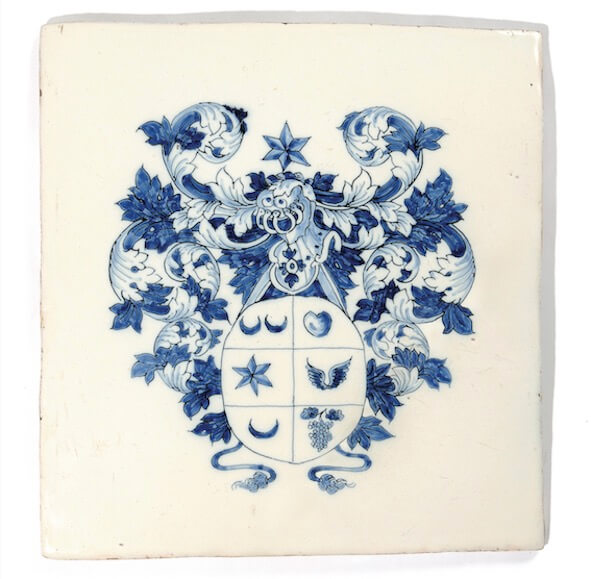
‘Wapengoet’: Armorial Wares
The wide assortiment that the Delft potters offered their clients contained also so-called ‘wapengoet’ or ‘armorial wares’, which were often commissioned for special occasions, such as a birth or a wedding. Made in Spanish lustreware and Italian maiolica since the fifteenth century, these objects have a long and storied history. The style was adopted in the Netherlands by the middle of the sixteenth century, with coats of arms appearing on tiles, plates, and dishes. These brightly colored pieces bear the coats of arms of cities, such as the Hanze cities at the IJssel river, grown wealthy by trade, and other important cities as Amsterdam and Haarlem.
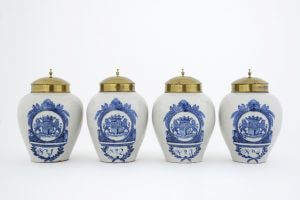 Nevertheless, objects bearing the coat of arms of cities stayed popular throughout the centuries, as can be seen in this set of four blue and white armorial tobacco jars and brass covers which were made around 1820. The jars are painted with the crowned coat of arms of the city of Rotterdam, which is supported by two rampant regardant lions. The banderole underneath is inscribed ‘T WAPE VAN ROTTERDAM’. The coat of arms was given by William I (c. 1286-1337), Count of Holland and Hainaut, to Rotterdam in thanks for the support of the lords of the Court of Wena in its fight against Flanders in 1304. The lions in the arms are the two red Dutch lions and the two black Hainaut lions, the golden lion supporters having been added in the sixteenth century.[1] The city of Rotterdam, the second largest in the Netherlands, has been a major shipping port since the fourteenth century, well positioned for trade between Holland, England and Germany. Although the port grew slowly, by the eighteenth century it had become the seat of one of the six ‘chambers’ of the Dutch East India Company (Vereenigde Oostindische Compagnie or VOC), and is now the largest port in Europe and after Shanghai, the second busiest in the world.
Nevertheless, objects bearing the coat of arms of cities stayed popular throughout the centuries, as can be seen in this set of four blue and white armorial tobacco jars and brass covers which were made around 1820. The jars are painted with the crowned coat of arms of the city of Rotterdam, which is supported by two rampant regardant lions. The banderole underneath is inscribed ‘T WAPE VAN ROTTERDAM’. The coat of arms was given by William I (c. 1286-1337), Count of Holland and Hainaut, to Rotterdam in thanks for the support of the lords of the Court of Wena in its fight against Flanders in 1304. The lions in the arms are the two red Dutch lions and the two black Hainaut lions, the golden lion supporters having been added in the sixteenth century.[1] The city of Rotterdam, the second largest in the Netherlands, has been a major shipping port since the fourteenth century, well positioned for trade between Holland, England and Germany. Although the port grew slowly, by the eighteenth century it had become the seat of one of the six ‘chambers’ of the Dutch East India Company (Vereenigde Oostindische Compagnie or VOC), and is now the largest port in Europe and after Shanghai, the second busiest in the world.
From the first decade of the seventeenth century, wapengoet such as jugs, plates and other objects with armorial decorations became increasingly popular. The wares were no longer reserved for cities, but were now marked with the newly ascribed coats of arms of individual citizens. The families without coats of arms could order pre-decorated plates with fantasy coats of arms.[2] The Delft factories not only received commissions for plates from Dutch families, but also from abroad. Emperor Carl VI (1685-1740) ordered plates with the Habsburg double eagle from De Metaale Pot (The Metal Pot) factory during the ownership of Lambertus van Eenhoorn. The royals of Denmark had dishes and ewers made with a double F monogram combined with a 4 for Friedrich IV (1699-1730), surrounded by stylized twigs and birds. The famous Lobkovicz dinner service, one of the largest surviving Delft dinner services, is lavishly decorated with the owner’s double monogram.[3]
The Webster family, Baronets of Battle Abbey, County Sussex, whose baronetcy 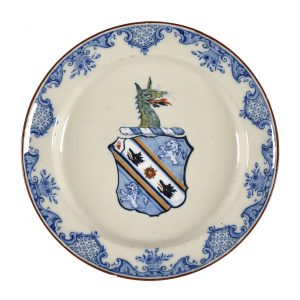 was created in 1703, but became extinct in 1923, also ordered Delftware an expensive armorial dinner service. Produced at De Grieksche A (The Greek A) factory during the ownership of Jan Teunis Dextra from 1757 to 1765, the polychrome charger is painted in the center with the coat of arms and dragon-head crest of Sir Whistler Webster, 2nd Baronet of Battle Abbey, County Sussex. Whistler Webster (1708-1779) was the eldest son of Thomas Webster (1676-1751), M.P. for East Grinstead, and his wife Jane Cheek (d. 1760), the granddaughter of Henry Whistler, an immensely wealthy merchant of London and Somerset, whose entire estate she inherited in 1719. Thomas Webster was created a Baronet by Queen Anne in 1703 and he bought Battle Abbey as his estate in 1719, the year of his wife’s vast inheritance. Their eldest son, Whistler, was returned as Member of Parliament for East Grinstead in the Election of 1741, a position he held for two decades until 1761, when he retired as an M.P., citing poor health. Sir Whistler had succeeded to the baronetcy on the death of his father in May 1751; and in 1766, at the relatively advanced age of 58, he embarked for the first time on marriage, taking as his bride Martha, the 37-year-old daughter of the Very Reverend Dr Richard Nairn, Dean of Battle. The marriage produced no children, so upon Sir Whistler’s death in 1779, the baronetcy was inherited by his younger brother, Sir Godfrey Webster, 3rd Baronet (d. 1780).[4]
was created in 1703, but became extinct in 1923, also ordered Delftware an expensive armorial dinner service. Produced at De Grieksche A (The Greek A) factory during the ownership of Jan Teunis Dextra from 1757 to 1765, the polychrome charger is painted in the center with the coat of arms and dragon-head crest of Sir Whistler Webster, 2nd Baronet of Battle Abbey, County Sussex. Whistler Webster (1708-1779) was the eldest son of Thomas Webster (1676-1751), M.P. for East Grinstead, and his wife Jane Cheek (d. 1760), the granddaughter of Henry Whistler, an immensely wealthy merchant of London and Somerset, whose entire estate she inherited in 1719. Thomas Webster was created a Baronet by Queen Anne in 1703 and he bought Battle Abbey as his estate in 1719, the year of his wife’s vast inheritance. Their eldest son, Whistler, was returned as Member of Parliament for East Grinstead in the Election of 1741, a position he held for two decades until 1761, when he retired as an M.P., citing poor health. Sir Whistler had succeeded to the baronetcy on the death of his father in May 1751; and in 1766, at the relatively advanced age of 58, he embarked for the first time on marriage, taking as his bride Martha, the 37-year-old daughter of the Very Reverend Dr Richard Nairn, Dean of Battle. The marriage produced no children, so upon Sir Whistler’s death in 1779, the baronetcy was inherited by his younger brother, Sir Godfrey Webster, 3rd Baronet (d. 1780).[4]
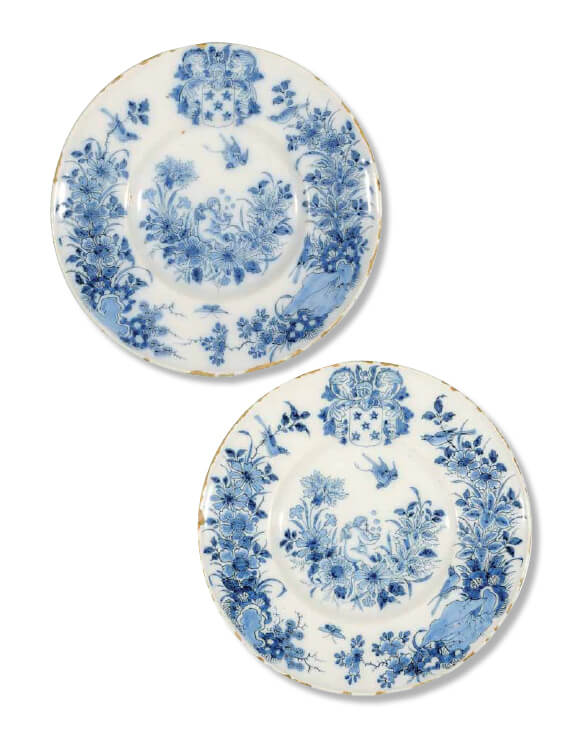
The style of the Delft armorial wares varied greatly from blue and white objects to polychrome and even gilded pieces. They remained stylish throughout the eighteenth century and continually followed the latest fashions. One such change was the placement of the coats of arms on the dishes. During the last quarter of the seventeenth century, Delftware painters followed Italian and French examples that depicted the coats of arms on the broad rim of the dishes. This can be seen in the pair of blue and white plates with the depiction of a Cupid blowing bubbles seated amidst a spray of lilies, a carnation and other large blossoms and leaves. Probably made around 1690 at De Grieksche A factory, the plates show the late seventeenth century style of depicting the coat of arms on the top of a wide rim. Although currently unidentified, the pierced mullets suggest an English coat of arms.
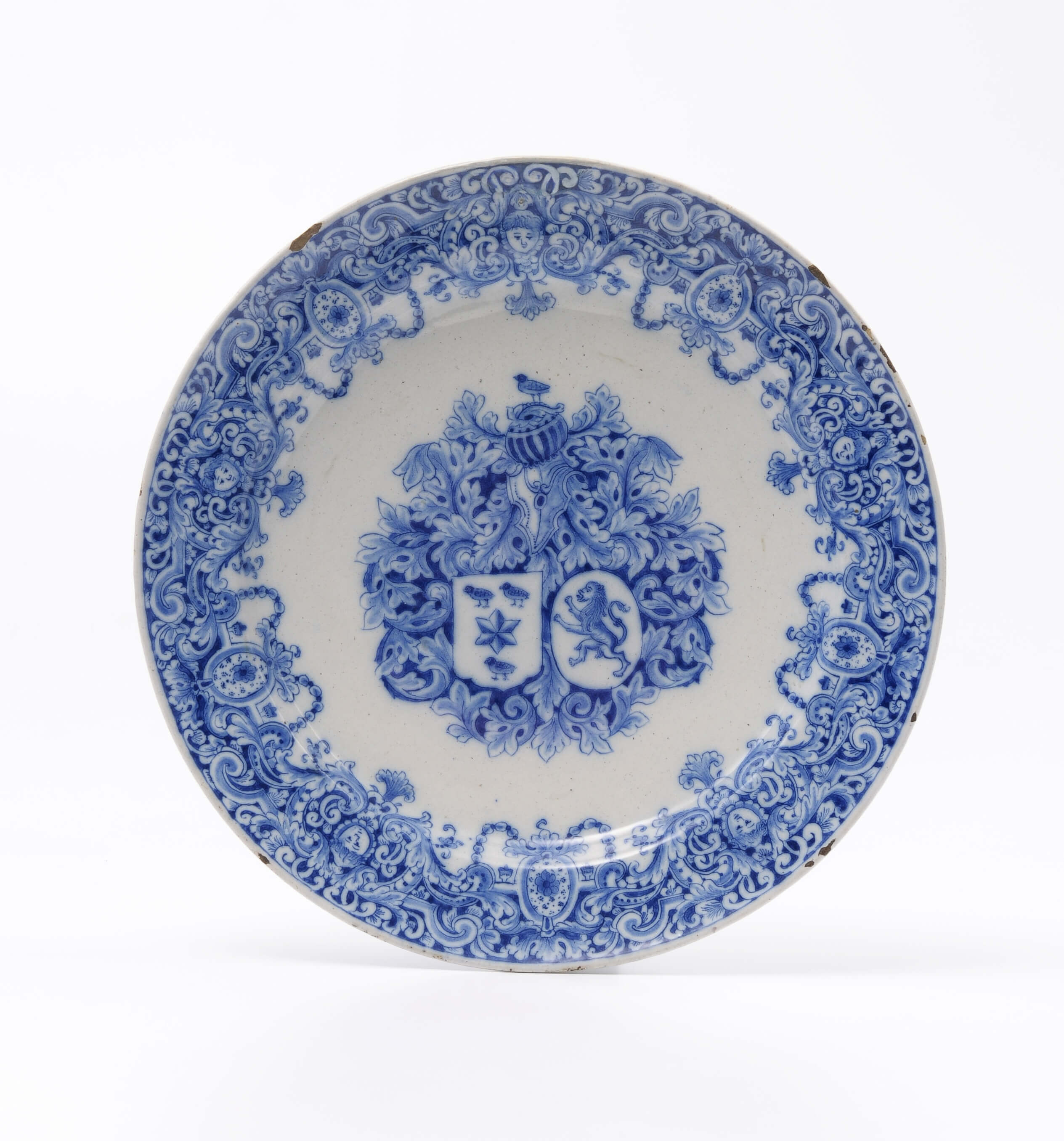 In the eighteenth century, however, the painters moved the symbols to the center of the dish, and gradually increased the size of the crest with elaborate decorations. The blue and white plate, made around 1755 and marked with an asterisk and the letters JB in blue for Justus van den Berg, who is recorded as a potter at De Witter Ster (The White Star) factory, shows two coat of arms within elaborate foliate mantling beneath a helmet and bird crest painted in the center. The absence of colors is sometimes, as here, compensated for by the richness of the decorative motifs. Two plates from this service are in the collection of the Musée National de Céramique in Sèvres, but unfortunately the arms have not been identified.[5] The opulent rinceaux relate to the engraved compositions of the goldsmith Michel Le Blon (1587 – 1656), and the masks and garlands of pearls are reminiscent of the ornamentation of Daniel Marot (1663-1752), who was the favoured designer of William III (1650-1702) and Mary II (1662-1694).[6]
In the eighteenth century, however, the painters moved the symbols to the center of the dish, and gradually increased the size of the crest with elaborate decorations. The blue and white plate, made around 1755 and marked with an asterisk and the letters JB in blue for Justus van den Berg, who is recorded as a potter at De Witter Ster (The White Star) factory, shows two coat of arms within elaborate foliate mantling beneath a helmet and bird crest painted in the center. The absence of colors is sometimes, as here, compensated for by the richness of the decorative motifs. Two plates from this service are in the collection of the Musée National de Céramique in Sèvres, but unfortunately the arms have not been identified.[5] The opulent rinceaux relate to the engraved compositions of the goldsmith Michel Le Blon (1587 – 1656), and the masks and garlands of pearls are reminiscent of the ornamentation of Daniel Marot (1663-1752), who was the favoured designer of William III (1650-1702) and Mary II (1662-1694).[6]
Based on the variety and multitude of Delft armorial wares, they were highly in vogue the seventeenth and eighteenth century in both the Netherlands and abroad.
[1] In 1948, to celebrate the bravery of the citizens of Rotterdam during World War II and their role in the liberation of their fatherland, Queen Wilhelmina (1880-1962, reigned 1890-1948) of the Netherlands presented the city with the motto “Sterker door strijd” (“Stronger through effort”), which has now been included on a banderole beneath the coat of arms.
[2] D.F. Lunsingh Scheurleer, Delft, Niederländische Fayence, München, 1984, p. 32.
[3] Illustrated in J.D. van Dam, Delffse Porceleyne, Dutch Delftware 1620-1850, Zwolle/Amsterdam (Rijksmuseum), 2004, p. 81.
[4] The dating of this plate can also be based on the coat of arms, which, when read heraldically reveals that it is the arms of a bachelor and of a baronet (indicated by the baronet’s badge of the ‘Red Hand of Ulster’ painted in the top left corner of the shield). As an elderly gentleman, failing in health, it is highly unlikely that Sir Thomas Webster, would have ordered a new and expensive dinner service for his household, decorated with a coat of arms that did not include his wife’s family arms. It is far more likely that the service was made for his son, Sir Whistler. Given that the arms are shown as for a baronet and a bachelor, the service would have to date from after 1751 when Sir Whistler inherited the title, but before 1766, when he married; and it can be reasonably supposed that the most likely time of manufacture would be either within the first few years of Sir Whistler having inherited his new title and estates, or possibly during his courtship of Miss Nairn, when he may have undertaken a certain amount of refurbishment of Battle Abbey to make his prospects more appealing. We are grateful to Mr. Brand Inglis for his assistance with this armorial identification.
[5] C. Lahaussois, Faïences de Delft, Musée national de Céramique Sèvres 1998, pp. 113-114.
[6] H.P. Fourest, Delftware, London 1980, p. 82.



